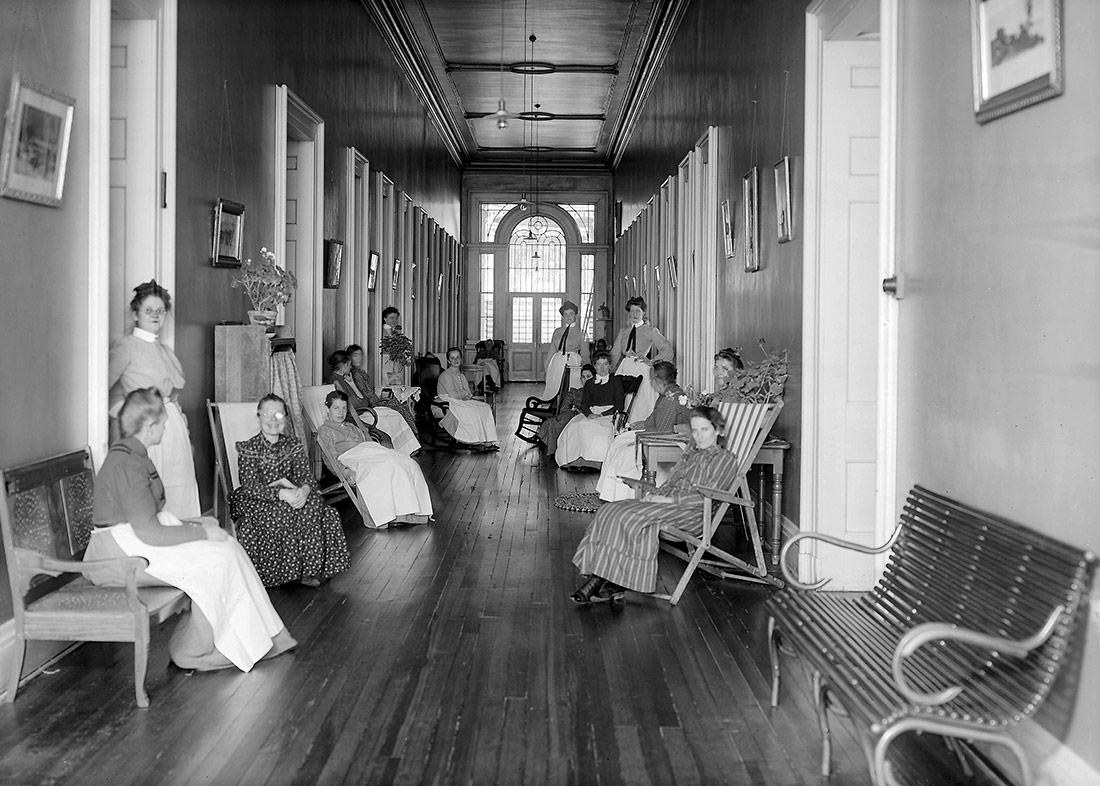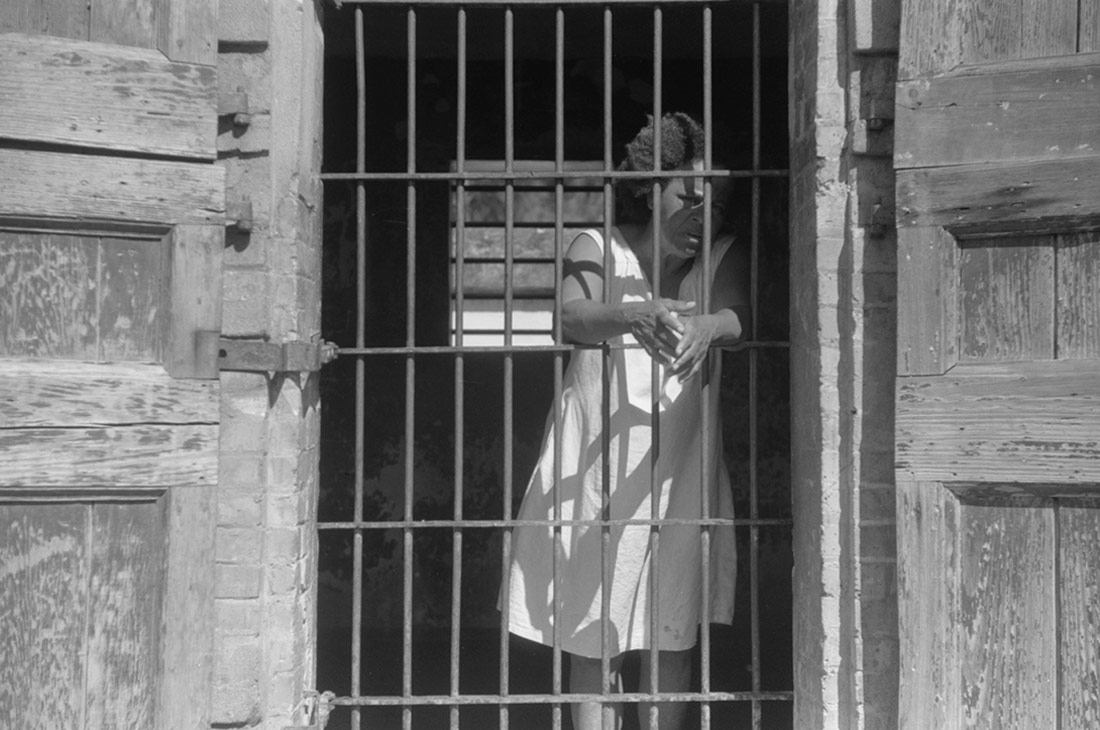
St. Louis City Insane Asylum women’s corridor, 1904 | City of St. Louis Water Department, Wikimedia Commons | Public domain
Modern psychiatric hospitals emerged in the early 19th century with the aim of preserving the values of charity and guardianship of the old asylums. However, shutting madness away proved to be a poor solution for providing the conditions needed to help people recover their sanity. In the mid-twentieth century, a change of paradigm made it possible to replace these types of hospital with a markedly communitarian model, opening the doors of these institutions to art and culture and revitalising the social life of their patients.
The history of mental institutions is an eminently political tale. An instrument of control for some, a means of treatment and cure for others, modern psychiatric hospitals emerged at the beginning of the 19th century within a society where mad people [1] had been (relatively) free up until then. That said, they enjoyed a (hypothetical) freedom which, depending on where and when they were born, placed them in the category of either enlightened or marginalised beings. The creation of mental institutions for treatment meant a change in the social paradigm for all of them. The community was finally dealing with the cases of all those who were, so to speak, different.
But the interpretation of that difference was (and is) entirely subject to the ideas of the observer. It could be appreciated for the diversity it brought to a group, or scorned for the hypothetical danger it posed to the pre-established norm. More along the lines of the latter perspective, the first psychiatric hospitals were intended to protect society from the ranks of the mad, and the latter from themselves. Those walls, still impregnated with old values such as charity or guardianship, shut madness away with no other promise than that of studying it and no other hope than that of recovery through treatments that were still too rudimentary. The will to cure existed, but people did not yet have the right tools or understand that, in some cases, there was no possibility of curing anything because, quite simply, there was nothing to cure.
The madness of isolation
The main problem with this model lay in the roots of its own philosophy. Locking a person away behind those doors meant plucking them out of their environment. A decontextualisation that, although appropriate and necessary for certain cases such as addictions, in other circumstances could have the opposite effect to that which was intended. Those who decried that there is nothing more maddening than being locked up in an insane asylum and treated as mentally ill, with all that this entails – from the diminishment of all personal freedoms to all types of coercive measures, and even the risk of losing conscious awareness due to dementia driven by the circumstances or due to medical procedures with devastating effects such as lobotomies – were right.

An inmate of the insane asylum at the hospital, 1941 | Jack Delano, Library of Congress | Public domain
The mad person was considered incapable of making her own decisions, given that her judgement was assumed to be clouded by that animalistic patina associated with mental derangement. A bestiality that, in a few exceptional situations, inspired some of these hospitals to become sadly famous for the tours they organised for the rest of society along corridors which, for one day a week and for the price of a penny, became makeshift circuses of insanity.
However, it would be unfair to consider the entire medical community of the time as nothing more than common torturers or circus entrepreneurs whose main interest was the punishment and exploitation of their patients. Lobotomy itself, now viewed akin to something out of a horror movie, was often propounded by progressive minds eager to improve the living conditions of these people. History is always complex, and trying to reduce the birth of an institution of such social relevance to a common place of control (or torture even) is as attractive to some as it is reductionist to anyone with an ounce of sense.
This does not detract from the fact that the medical professional was placed in a position of power over the supposedly ill person, placing in the hands of the former all essential decisions on the fate of the latter. And, above all, creating this hierarchy of caregiver and patient, where the mad person was stripped of any relationship with life on the outside, only being allowed contact with caregivers or other people in the same situation. They lost their jobs (if they had one) and their leisure or cultural interests, based on the diagnosis that a sick mind did not need all those stimuli to heal. Time stopped when they entered these institutions, perhaps never to be restarted again.
I am me and my circumstances
It was only with the passage of time that it was discovered that this forced isolation was not only unfavourable for all those on whom it was imposed, but that it could also take its toll on their already delicate mental health. This discovery, together with parallel revolutions in the political and cultural spheres, promoted a new paradigm shift that would result in the gradual abandonment of the asylum model in favour of a type of communitarian intervention. The mad person ceased to be an island and once again became part of the social conglomerate, managing to resignify those previous periods of reclusion into opportunities for personal growth.
The role of psychiatrists such as Francesc Tosquelles was decisive in this change of perspective in the mid-twentieth century. Envisaging a model of psychiatry that was not only purely biological (and almost self-absorbed), but which also included aspects such as political organisation and cultural creation, resulted in much more humane treatments that allowed mentally ill people to recover their autonomy. In this way, treatment became not so much about dealing with the illness itself, but about transforming the institution to make it the right place to encourage the desired improvement in mental health.
This new approach reflected Ortega y Gasset’s famous aphorism: “I am me and my circumstances, and if I don’t change them, I can’t save myself”. It made no sense to work with the individual without working on his or her environment, and this included the space itself as well as the professionals who inhabited it and the practices that were carried out there. So it was that the light of the arts once again illuminated those places previously covered in social darkness. Theatre, film and surrealist art burst into the lives of people who also began to work and earn money in pursuit of personal autonomy. They were self-organised places that enjoyed a rich interaction with their environment, opening the doors to a society that stopped seeing them as places to shun and even discovered virtues in some of them through avant-garde movements such as outsider art. The line between what was considered normal and what was pathological began to blur and madness came to be perceived as an essential feature of our personality.
But as we said, we must not fall prey to false dichotomies. However radical the ideals of professionals such as Tosquelles may sound, the prescription of medication and practices such as electroshock treatment continued to exist for many years (and still do, in fact). Because, as we said before, no extreme is good. Neither can the purely communitarian approach combat certain mental conditions that require pharmaceutical help, nor can the purely biological approach allow for appropriate management of all the conditioning factors beyond the limits of our bodies.
Today, despite living under the dictatorship of anxieties and depressions that promote the philosophy of medication for everything, the pendulum between these two poles is swinging back towards the communitarian approach, but it would be foolish to forget all that we have learned along the way. Beckett said that we are all born mad and some remain so. Let us honour the memory of those who lived through worse times so that we do not fall over the same stumbling block (of madness) again.
[1] Throughout the article, the words “mad” and “madness” are used not with a pejorative spirit but with the sincere intention of redefining these terms or concepts as a synonym for that which is different from the perspective of the human mind. Different or distant from the supposed norm, but not worse (or better).



Leave a comment